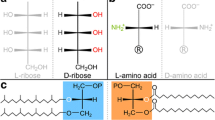Abstract
Amino acid homochirality, as a unique behavior of life, could have originated synchronously with the genetic code. In this paper, phosphoryl amino-acid-5′-nucleosides with P-N bond are postulated to be a chiral origin model in prebiotic molecular evolution. The enthalpy change in the intramolecular interaction between the nucleotide base and the amino-acid side-chain determines the stability of the particular complex, resulting in a preferred conformation associated with the chirality of amino acids. Based on the theoretical model, our experiments and calculations show that the chiral selection of the earliest amino acids for L-enantiomers seems to be a strict stereochemical/physicochemical determinism. As other amino acids developed biosynthetically from the earliest amino acids, we infer that the chirality of the later amino acids was inherited from the precursor amino acids. This idea probably goes far back in history, but it is hoped that it will be a guide for further experiments in this area.
Similar content being viewed by others
References
Schimmel P, Giege R, Moras D, et al. An operational RNA code for amino acids and possible relationship to genetic code. Proc Natl Acad Sci USA, 1993, 90: 8763–8768
Di Giulio M. On the origin of the genetic code. J Theor Biol, 1997, 187: 573–581
Di Giulio M. Physicochemical optimization in the genetic code origin as the number of codified amino acids increases. J Mol Evol, 1999, 49: 1–10
Wachtershauser G. The origin of life and its methodological challenge. J Theor Biol, 1997, 187: 483–494
Di Giulio M. Reflections on the origin of the genetic code: A hypothesis. J Theor Biol, 1998, 191: 191–196
Bonner W A. Parity violation and the evolution of biomolecular homochirality. Chirality, 2000, 12: 114–126
Bailey J. Chirality and the origin of life. Acta Astronautica, 2000, 46: 627–631
Jorissen A, Cerf C. Asymmetric photoreactions as the origin of biomolecular homochirality: A critical review. Origins Life Evol Biosphere, 2002, 32: 129–142
Aylward N N, Bofinger N. The reactions of methanimine and cyanogen with carbon monoxide in prebiotic molecular evolution on earth. Origins Life Evol Biosphere, 2001, 31: 481–500
Cheng C M, Liu X H, Li Y M, et al. N-phosphoryl amino acids and biomolecular origins. Origins Life Evol Biosphere, 2004, 34: 455–464
Ferris J P, Hill A R, Liu R H, et al. Synthesis of long prebiotic oligomers on mineral surfaces. Nature, 1996, 381: 59–61
Zaia DAM. A review of adsorption of amino acids an minerals: As it important for origin of life? Amino Acids, 2004, 27: 113–118
Eschenmoser A. Chemistry of potentially prebiological natural products. Origins Life, 1994, 24: 389–423
Baltscheffsky H, Blomberg C, Liljenstrom H, et al. On the origin and evolution of life: An introduction. J Theor Biol, 1997, 187: 453–459
Yamagata Y, Watanabe H, Saitoh M, et al. Volcanic production of polyphosphates and its relevance to prebiotic evolution. Nature, 1991, 352: 516–519
Kolb V, Zhang S B, Xu Y, et al. Mineral induced phosphorylation of glycolate ion—a metaphor in chemical evolution. Origins Life Evol Biosphere, 1997, 27: 485–503
Tsuhako M, Nakahama A, Ohashi S, et al. The reaction of cyclo-triphosphate with ethylenediamine. Bull Chem Soc Jpn, 1983, 56: 1372–1377
Tsuhako M, Fujimoto M, Ohashi S, et al. Phosphorylation of nucleosides with cyclo-triphosphate. Bull Chem Soc Jpn, 1984, 57: 3274–3280
Zhou W H, Ju Y, Zhao Y F, et al. Simultaneous formation of peptides and nucleotides from N-phosphothreonine. Origins Life Evolution Biosphere, 1996, 26: 547–560
Arrhenius G, Sales B, Mojzsis S, et al. Entropy and charge in molecular evolution-the case of phosphate. J Theor Biol, 1997, 187: 503–522
Seligmann H, Amzallag G N. Chemical interactions between amino acid and RNA: Multiplicity of the levels of specificity explains origin of the genetic code. Naturwissenschaften, 2002, 89: 542–551
McGuigan C, Pathirana R N, Balzarini J, et al. Intracellular delivery of bioactive AZT nucleotides by aryl phosphate derivatives of AZT. J Med Chem, 1993, 36: 1048–1052
Pin Y, Daxiong H. Molecular modeling of the binding mode of chiral metal complexes [Co(phen)2dppz]3+ with B-DNA. Sci China Ser B-Chem, 2000, 43(5): 516–523
HyperChem release 6.0 for windows, molecular modeling system, Hypercube Inc. Florida USA, 2000
Trifonov E N. Consensus temporal order of amino acids and evolution of the triplet code. Gene, 2000, 261: 139–151
Di Giulio M. The coevolution theory of the origin of the genetic code. Phys Life Rev, 2004, 1(2): 128–137
Szathmary E. Coding coenzyme handles: A hypothesis for the origin of the genetic code. Proc Natl Acad Sci USA, 1993, 90: 9916–9920
Di Giulio M, Medugno M. The historical factor: The biosynthetic relationships between amino acids and their physicochemical properties in the origin of the genetic code. J Mol Evol, 1998, 46: 615–621
Hartman H. Speculations on the origin of the genetic code. J Mol Evol, 1995, 40: 541–544
Ikehara K, Omori Y, Arai R, Hirose H. A novel theory on the origin of the genetic code: A GNC-SNS hypothesis. J Mol Evol, 2002, 54: 530–538
Author information
Authors and Affiliations
Corresponding author
Additional information
Supported by the National Natural Science Foundation of China (Grant No. 20572061) and the Science Foundation of Xiamen University (Grant No. Z03120)
Rights and permissions
About this article
Cite this article
Han, D., Chen, W., Han, B. et al. A new theoretical model for the origin of amino acid homochirality. SCI CHINA SER C 50, 580–586 (2007). https://doi.org/10.1007/s11427-007-0087-0
Received:
Accepted:
Issue Date:
DOI: https://doi.org/10.1007/s11427-007-0087-0




